An animal with a backbone or spinal column is called a vertebrate. Humans, dogs, snakes, and birds are examples of vertebrates, while insects, worms, jellyfish, and snails are not. A few vertebrates, such as rats and mice, are common pests in urban and industrial sites.
Others are not pests in their normal habitats, but may occasionally become pests when they conflict with humans. A skunk in the woods is a beneficial part of nature; a skunk nesting in the crawlspace of a home is an entirely different matter.
Some vertebrates that are serious pests in particular situations are never considered to be pests by certain people. Pigeons, for example, can cause human health problems when roosting in large numbers. Commonly, their droppings foul sidewalks, contaminate food, and damage automobile paint. But pigeons are seen as pets and friends by many city dwellers who feed them daily. These constituents react angrily to any attempt to poison or trap pigeons.
People feel a strong attachment towards vertebrates that they do not feel towards other pests. Children in particular love and cherish them. Many people today are involved emotionally in protecting the welfare of animals, particularly vertebrates.
Control of vertebrates other than rats and mice is more of a public relations problem than a pest problem. Killing is the control method of last resort. Public concern for the welfare of animals and the risk from vertebrate poisons to people, pets, and other nontargets have made rules governing vertebrate pest control particularly strict. Be sure you understand all the regulations that apply in your geographic area.
KINDS OF RATS
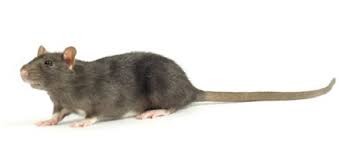
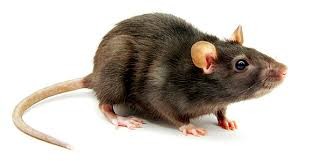
Two most important pest rats are the Norway rat (Rattus norvegicus) and the roof rat (Rattus rattus).
- The Norway rat is also called the brown rat, house rat, sewer rat, and wharf rat.
- The roof rat is also called the black rat, ship rat, and Alexandrine rat.
The two species look much alike but there are noticeable differences. In general: (see field identification chart)
- A Norway rat looks sturdier than the roof rat; the roof rat is sleeker.
- A mature Norway rat is 25 percent longer than a roof rat, and weighs twice as much.
- A Norway rats tail is shorter than the length of its head and body combined; a roof rats tail is longer than its head and body.
- A Norway rats ears are small, covered with short hairs, and cannot be pulled over the eyes; a roof rats ears are large, nearly hairless, and can be pulled over the eyes.
- A Norway rats snout is blunt; the roof rats snout is pointed.
HABITS OF RATS
Rats must be understood to be controlled. Knowledge of their life histories, habitat and food requirements, patterns of behavior, range and other factors is essential to their management. The Norway and Roof rats have similar habits. Most of the discussions below apply to either kind of rat. Where differences are important for control purposes, however, the differences will be highlighted.
Rats have caused more human suffering and more economic damage than any other vertebrate pest. From plague epidemics (the Black Death of Europe) to rat-bite fever, whether feeding on stored grain or gnawing electric wires, rats are enemies of humankind. Statisticians estimate that rats destroy 20 percent of the worlds food supply every year — directly by feeding and indirectly through contamination. Yet, rats can be admired.
They have adapted to nearly all human environments. They live in granaries, in fields, in city sewers, on ocean-going ships, on roofs, in attics, in basements, in street trees, on top of 30-story buildings, and inside subway tunnels.
Adept athletes, rats can leap three feet straight up and four feet horizontally. They can scramble up the outside of a pipe three inches in diameter, and climb inside pipes one-and-a-half to four inches in diameter. They can walk between buildings on telephone or power lines, and scramble on board a ship on its mooring line. Rats can swim through a half mile of open water, tread water for up to three days, swim against a strong current in a sewer line, and dive through a sewer trap to pop up inside a toilet. They can fall more than 50 feet and survive.

Rats gnaw constantly; their teeth are extremely hard. They commonly chew through building materials such as cinder block, aluminum siding, sun-dried adobe brick, wall board, wooden cabinets, lead sheathing, and plastic or lead pipes. After gnawing a hole, an adult rat can compress its body and squeeze through an opening only a half-inch high. In most instances, rats are very wary.
Hundreds may be nesting in a city block — in underground burrows, in sewers, on roofs, inside buildings with few people in the area realizing it. Populations are dynamic: rats moving in, rats moving out, rats giving birth, and rats dying. Within a population, some rats will be easy to control, some difficult. Successful long term rat control is not simple. The key is to control rat populations, not individual rats. Rat control requires an integrated approach that includes nonlethal tools such as careful inspection, upgraded sanitation, and rat-proofing structures. Lethal control often combines the use of rodenticides with nontoxic control measures such as snap traps or glue boards.
LIFE CYCLE
A mature female rat can give birth to about 20 young in a year (4 to 6 at a time), if she lives that long. The average life span of a rat in the field is less than one year; females live longer than males. The young are born in a nest. They are hairless, and their eyes and ears are closed. Within two weeks their eyes and ears open, they become furry and rat-like, and they begin exploring the nest area. In the third week they begin to eat solid food, and imitate their mother to forage, escape, and watch for danger.
If the mother rat has become wary of rodenticides or traps, many of her young will learn to avoid them. This learning experience can make control difficult in sites where long term rodent control programs have been unsuccessful in the past. Young are totally weaned at four or five weeks old. They then weigh about 1 l/2 ounces. At three months, the young are independent of their mother. They will mate and continue the cycle in the same location or will migrate to a new, unoccupied nest area.
Social Behavior
Rats are social animals and live in colonies with well-defined territories that they mark with urine and glandular secretions. The colony has a complex social hierarchy with a dominant male leader and a pecking order of subordinate males and ranking females. The strongest and most dominant animals occupy the best nest and resting sites, and feed at their leisure. Weaker, subordinate rats are pushed out to less favorable sites, or forced out of the territory completely.
Rats are aggressive, and social conflicts are most common at feeding sites, prime resting areas, and territorial boundaries. Females fiercely defend their nest and young from other rats.
Senses of Rats
Rats have poor vision. They are nearly color blind, and react to shapes and movement rather than identifying objects by sight. Thirty to forty-five feet is the limit of their vision. Their eyes are adapted to dim light.
Other senses, however, compensate for poor vision. They use their sensitive nose to locate food, follow pathways, tell whether another rat is friend or foe, and identify new objects in their territory. They use long whiskers and guard hairs to touch their way through dark burrows, pipe chases, wall voids, and other runways. Their ears detect faint sounds that signal danger. Rats can taste certain chemicals at a parts-per-million concentration. [This explains why rats often reject baits or avoid traps that have been contaminated with insecticides.]
Finally, rats have an excellent sense of balance which allows them to walk on wires and always land on their feet in a fall.
Fear of New Objects (Neophobia)
Rats are wary of anything new that appears in their territory. A bait station, a trap, a block of wood will be avoided for a few days until the rats become familiar with the new object; even then, they approach cautiously, This fear of new objects can make baiting and trapping difficult. Rats will avoid poison bait when it is first placed. Later, they may nibble warily. If the poison bait makes them ill, but doesnt kill them, they will avoid similar baits or stations in the future.
Food & Water
Rats need about one ounce of food daily. Norway and roof rats prefer different types of food. Norway rats prefer protein-based foods such as meat, fish, insects, pet food, nuts, and grain. Household garbage is ideal food for Norway rats. Roof rats prefer plant materials such as fruits, nuts, seeds, berries, vegetables, and tree bark. They occasionally feed on garbage and meats. Each rat species, however, will feed on non-preferred food if nothing else is available.
Rats often cache or hoard food in hidden areas. This food may or may not be eaten when other food supplies run short. Hoarding is important for two reasons. First, rats may be moving toxic bait into a location where the label does not permit it to be. Second, rats may be hoarding poison bait while feeding on their regular food; thus, a baiting program becomes ineffective.
Rats need water every day. The amount varies, depending on the moisture content of their food, but is usually around 1/2 to one fluid ounce. Rats prefer to nest where water is easily available.
Range
Rats usually begin foraging just after dark. Most of their food gathering occurs between dusk and midnight, but short bursts of restlessness and activity can occur anytime, day or night. Rats commonly travel 100 to 150 feet from their nest looking for food and water and patrolling their territory. It is not unusual for a colony of rats that nests outdoors to forage inside a building 100 feet away.
Nests
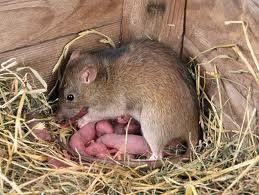
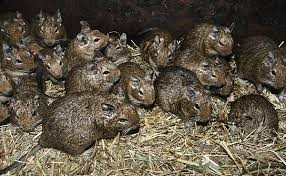
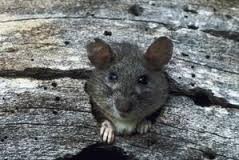
Outdoors: Norway rats usually nest in burrows dug into the ground. The burrows are shallow (less than 18 inches) and usually short (less than three feet), with a central nest. Extra bolt holes are used for emergency escapes. They are hidden under grass or boards or lightly plugged with dirt. Burrow openings are two to four inches in diameter.
Indoors: Norway rats nest inside walls, in the space between floors and ceilings, underneath equipment, between and under pallets, and in crawl spaces, storage rooms, and any cluttered area that is normally unoccupied. Norway rats prefer to nest in the lower floors of a building.
Roof rats commonly nest above ground in trees — particularly untrimmed palm trees, and in piles of wood or debris, vine-covered fences, and stacked lumber. Overgrown landscaping is also a prime nesting area. Roof rats will sometimes nest in burrows if above-ground sites are limited and Norway rats are not nesting in the area. Indoors: Roof rats prefer to nest in the upper levels of a building in the attic and in ceiling and attic voids near the roof line. But at times they also nest in the lower levels of a building as do Norway rats.
Both species also nest in sewers and storm drains, and both on occasion can be found in highly unusual nest sites. Both Norway and roof rats can have several hotel nest sites in an area. A rat may spend a week in its home base and then move for a day or two into a secondary hotel nest site. Norway rats have been shown on occasion to have a home range of up to 20 acres when these secondary nest sites were included in the calculations.
Rats as Disease Carriers
Rats are responsible for the spread of many diseases. Sometimes they transmit the disease directly, by contaminating food with their urine or feces. Sometimes they transmit disease indirectly, for example, fleas biting first an infected rat, then a person. Following are some of the more important diseases associated with rats:
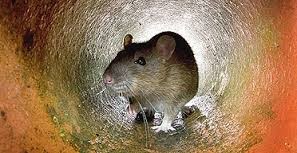
Plague
The Great Plague of London killed half of the citys population. The Black Death of Europe lasted 50 years in the 14th Century and killed 25 million people. In the first quarter of this century, an estimated 11 million people died in Asia from plague.
The disease is transmitted primarily to man by the oriental rat flea. The flea bites an infected rat, and then, feeding on a human, inoculates them with the bacteria that cause the disease. Although no major urban outbreak of plague has occurred since 1924, this is not a disease of the past. A reservoir of plague exists in some populations of wild rodents in several United States. Humans contacting these rodents could contract the disease. As suburbia expands into undeveloped areas, wild rodents can transmit the disease to urban rats. There is a danger that an outbreak of urban plague can occur in the United States.
Murine Typhus Fever
Murine typhus occurs in California and in southeastern and Gulf Coast states. It is a relatively mild disease in humans. As with plague, murine typhus is transmitted from rats to humans by a rat flea. In this case, however, the disease organism enters the bloodstream when feces of infected fleas are scratched into a flea-bite wound.
Rat-Bite Fever
Rats bite thousands of people each year; most bites occur in inner cities. [In some cases victims, particularly infants and bed-confined elderly are bitten in the face while sleeping.] A small percentage of those bitten develop rat-bite fever. The bacteria that causes the disease is carried in the teeth and gums of many rats. Although the disease exhibits mild symptoms similar to flu in most cases, it can be fatal. It is of particular risk to infants.
Salmonella Food Poisoning
Rats frequent sewers, rotting garbage, cesspools, and similar sites where Salmonella bacteria thrive. The bacteria also thrive in the intestinal tracts of rats. If infected rats travel to stored food, or dishes and silverware, or food preparation surfaces, their droppings can transmit Salmonella food poisoning to humans.
Leptospirosis or Weils disease
Human cases of this disease are seldom fatal. The disease organisms are spread from rat urine into water or food, and enter humans through mucous membranes or minute cuts and abrasions of the skin.
Trichinosis
Trichinosis results from a nematode, or tiny roundworm, that invades intestines and muscle tissue. Both people and rats get the disease from eating raw or undercooked pork infected with the nematode. Rats help spread trichinosis when hogs eat food or garbage contaminated with infested rat droppings.
About Rabies – Never
Rats have never been found to be infected with rabies in nature. Rabies transmission from rats to humans has never been documented. Public Health Service recommends against anti-rabies treatments in the case of rat or mouse bites.
Control & Management
Most successful rat control programs use a combination of tools and procedures to knock down the rat population, and to keep it down. Methods used combine habitat alteration and pesticide application. Some of the tools, such as baiting and trapping, are lethal to the rat. Some tools are not; rat-proofing, for example. Sometimes applicators recommend changes that their customers need to make, such as increasing the frequency of garbage pickup or making building repairs.
Sanitation
Food. Like all animals, rats need food to survive. Baiting programs often fail because the bait cant compete with the rats regular food. The rats simply ignore the baits or cache them. Reducing the rats normal food encourages them to feed on any rodenticide baits placed in their territory.
- Close or repair dumpsters and garbage containers that are left open or damaged.
- Clean food spills.
- Do not allow food to be left out overnight.
Outdoors: Remove seeds spilled under bird feeders or food around doghouses. In warehouses and food plants, look for spills around railroad tracks and loading docks. Ensure food in storage is rotated properly (first in, first out) and is stored on pallets, not on the ground or against walls. The pallets should be 18-24 inches from side walls and placed so that aisles permit inspection and cleaning around the stored food.
Eliminate hiding places.
- Remove plant ground covers such as ivy near buildings.
- Remove high grass, weeds, wood piles, and construction debris that permit rats to live and hide adjacent to a building.
- Reduce clutter in rarely-used rooms – basements, storage rooms, equipment rooms. Organize storage areas.
Rat-Proofing (Exclusion)
Long term, the most successful form of rat control is to build them out. Also called rat-proofing, this technique makes it impossible for rats to get into a building or an area of a building. Rat-proofing prevents new rats from re-infesting a building once it has been cleared.
Building Exterior
- Seal cracks and holes in building foundations and exterior walls.
- Block openings around water and sewer pipes, electric lines, air vents, and telephone wires.
- Screen air vents.
- Caulk and seal doors to ensure a tight fit, especially between door and floor threshold.
- Fit windows and screens tightly.
- Caulk and close openings on upper floors and the roof, inspect under siding and repair damaged soffits.
- Repair breaks in the foundation below ground level.
Building Interior
- Seal spaces inside hollow block voids or behind wallboard.
- Repair broken blocks and holes around pipes.
- Repair gnaw holes or stuff them with copper wool.
- Equip floor drains with sturdy metal grates held firmly in place.
Rodenticides
A rodenticide is a pesticide designed to kill rodents. There are three major formulations of rodenticides used to control rats: food baits, water baits, and tracking powders.
Food Baits. Rat baits combine a poison effective against rats with a food bait attractive to rats. At one time, applicators mixed their own baits. Now baits are mostly purchased ready-made and packaged as extruded pellets, in a dry meal, or molded into paraffin blocks for wet sites. Baits may be obtained in 45-pound bulk tubs, in place packs containing less than one ounce of bait, or anything in between. Some baits kill rats after a single feeding, some require multiple feedings. Some are anticoagulants [causing rats to bleed to death], some affect respiration, and others have totally different modes of action. Some are only slightly toxic to people or pets, some moderately toxic, and some very toxic. Many of the old, ancient poisons that were toxic to humans were also used to poison rodents.
Experimentation with poisons for killing rodents, produced rodenticides made of arsenic, cyanide, strychnine, etc.: stomach poisons, that were mixed with food and had such extreme toxicity that they killed any animal that ingested them in sufficient amounts. Rats that did not eat a lethal dose, however, recovered, became bait shy and communicated their preference — or revulsion — to others in the colony.
Because of this, these poisons were undependable.
A new type of rodenticide was developed in the 1940s that reduced the clotting ability of the blood. This material became Warfarin, the first anticoagulant rodenticide. Others followed: warfarin, coumafuryl, chlorophacinone, diphacinone, pindone, valone.
The anticoagulents were effective and did not cause bait shyness.
Bait boxes. A tamper-proof bait box is designed so that a child or pet cannot get to the bait inside, but the rat can. Bait trays and flimsy plastic or cardboard stations are not tamper-proof bait boxes. Tamper-proof boxes differ in the type and quality of construction, but they are usually metal or heavy plastic. Rat bait stations are normally larger than those used for mice. Most designs are not considered to be truly tamperproof unless they can be secured to the floor, wall, or ground.
- Ensure that bait boxes are clearly labeled with a precautionary statement.
- Check stations or boxes periodically to ensure rats are taking the bait and that the bait is fresh. [Rats will rarely feed on bait that has spoiled.]
- Bait boxes should be placed wherever the rats are most active as determined by droppings and other signs (near burrows, along walls, and at other travel sites, etc.).
- Rut place packs in burrows, in wall voids, and similar protected sites. If a site is damp, use paraffin bait blocks or other water-resistant formulations. Roof rats often need to be baited in areas above ground such as attics, trees, and roofs.
- Rut out enough bait and check it often. [Incomplete baiting can lead to bait shyness and make control difficult.]
- Be sure to limit the rats normal food supply or your baits may be rejected.
- Remember that rats fear new objects at first so that your baits may not be taken for a few days or a week.
- Once bait is taken, leave the box in place for some time; the rats now consider it to be part of their normal surroundings.
- Good bait placements can be effective even when placed 15 to 50 feet apart. Bait placed outdoors around a commercial building can kill rats that are moving in from nearby areas.
Water baits. Rats drink water daily if they can. When rat water supplies are short, water baits – specially formulated rodenticides that are mixed with water – can be extremely effective. Several types of liquid dispensers are available. The best are custom designed for toxic water baits, but plastic chick-founts can also be used in protected sites. Use water baits only where no other animals or children can get to them.


